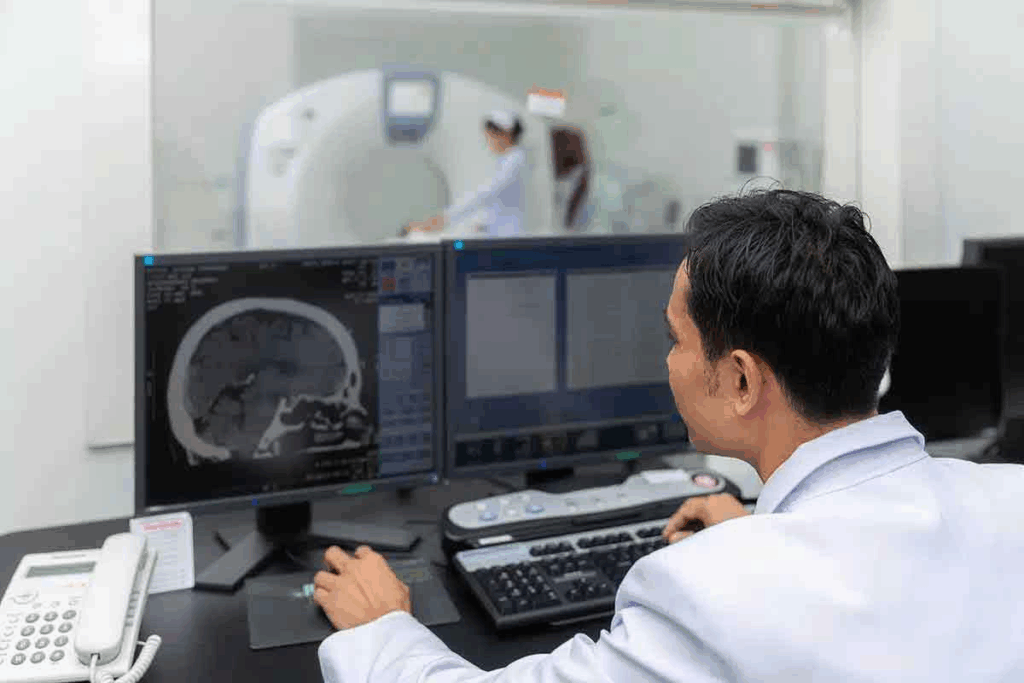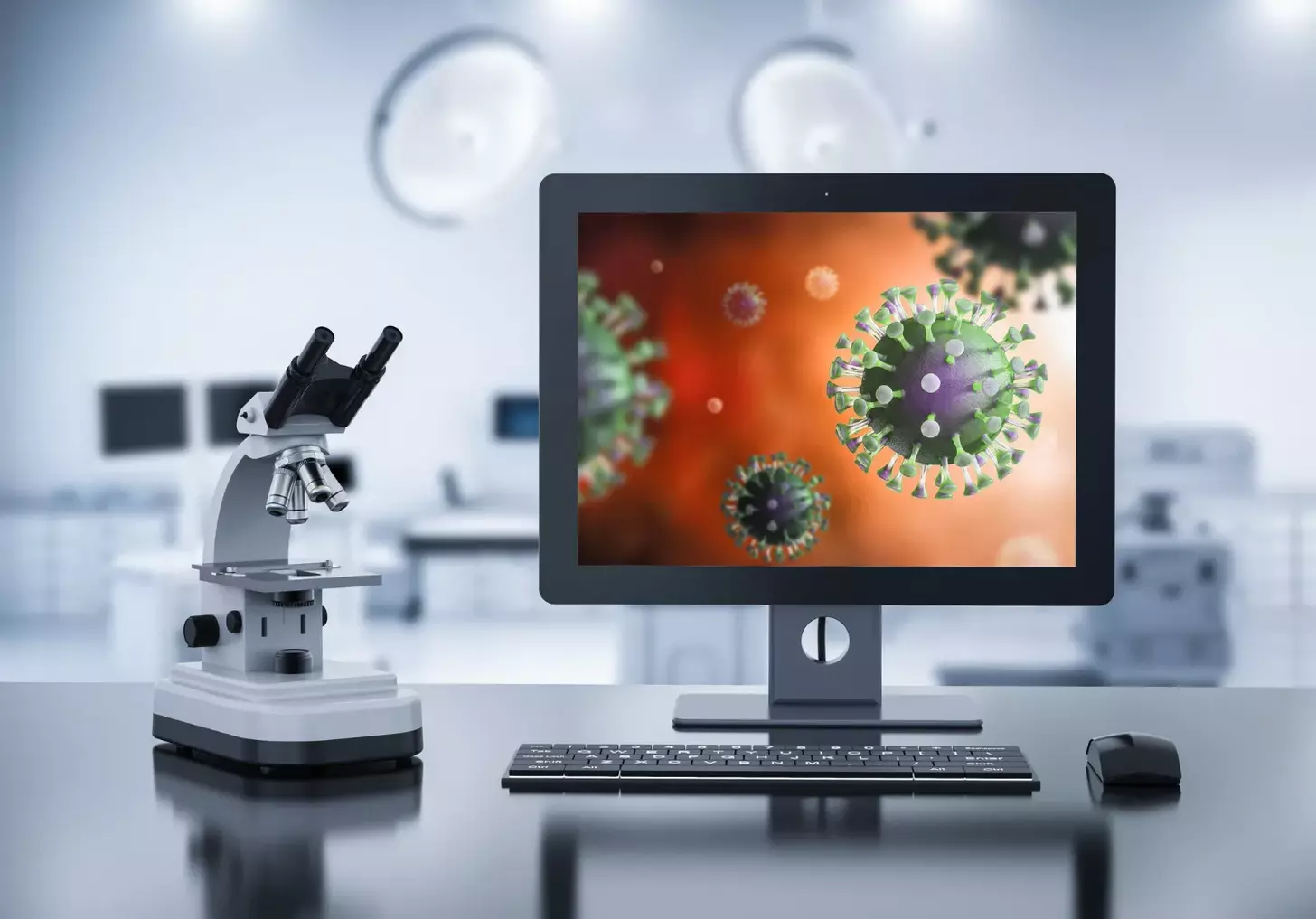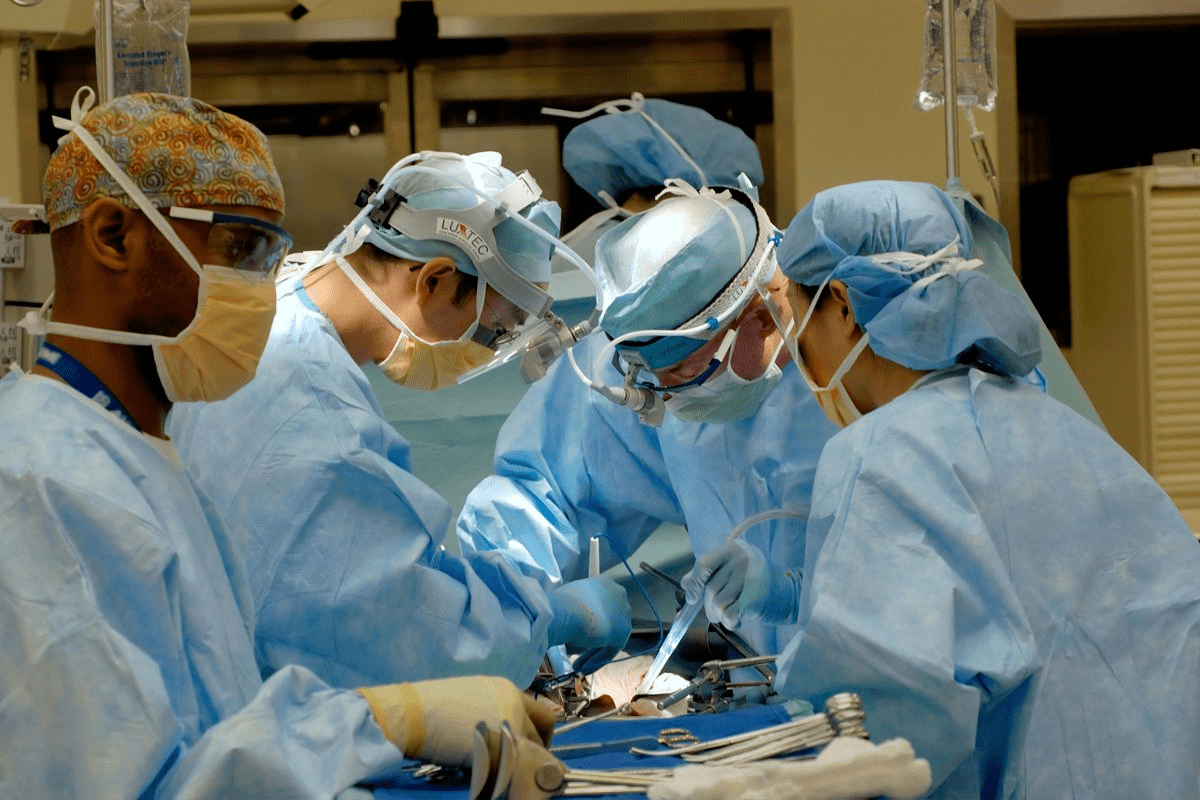Last Updated on November 27, 2025 by Bilal Hasdemir

Understanding the difference between PET and MRI scans is important for accurate diagnosis and better healthcare. At Liv Hospital, we prioritize using the right imaging technique to ensure precise results.
PET scans detect changes in cells, making them useful for identifying conditions like cancer. In contrast, MRI scans provide detailed images of the body using magnetic fields and radio waves. Knowing the difference between PET and MRI helps doctors choose the most appropriate scan for each patient, improving overall care.
Key Takeaways
- Understand the fundamental differences between PET and MRI scans.
- Learn how PET scans detect metabolic changes.
- Discover how MRI scans provide detailed body structure images.
- Recognize the importance of choosing the right scan for diagnosis.
- Find out how Liv Hospital ensures accurate and personalized care.
What Are PET Scans and MRI Scans?

First, let’s understand what PET scans and MRI scans are. These medical imaging technologies have changed how we diagnose diseases. PET and MRI scans lead this change.
Definition and Basic Purpose of PET Scans
A PET (Positron Emission Tomography) scan shows how your body’s tissues and organs work. It uses a special drug that lights up on the scan. This is great for finding metabolic changes in the body, like in cancer, brain disorders, and heart disease.
PET scans help find metabolic activity in the body. This is key for diagnosing and treating diseases where metabolic changes happen first.
Definition and Basic Purpose of MRI Scans
An MRI (Magnetic Resonance Imaging) scan is a non-invasive test. It uses strong magnets and radio waves to see inside the body. MRI scans are great for looking at anatomical details. They are often used for brain, spine, joint, and other body part issues.
MRI scans give detailed images of the body’s inside. This helps doctors find many conditions, like injuries, infections, tumors, and blood vessel diseases.
Why These Imaging Technologies Matter in Modern Medicine
PET and MRI scans are key in modern medicine. They give doctors the info they need to diagnose and treat many health issues. Here’s why they’re important:
- PET scans spot metabolic changes early, which is vital for managing diseases like cancer.
- MRI scans show detailed anatomical images, helping find structural problems.
- Together, they give a full view of the body’s function and structure.
In summary, PET scans and MRI scans are essential for diagnosing. Each has its own strengths. Knowing what they do and why they’re important helps us see their value in healthcare.
The Fundamental Difference Between PET and MRI

PET scans and MRI scans are both used to help doctors diagnose. But they show different things. PET scans look at how things work, while MRI scans show the details of what things look like.
Function vs. Structure: The Core Distinction
The main difference is what each scan measures. PET scans check how well tissues and organs work by looking at their metabolic activity. This is key for spotting diseases like cancer early, when they’re just starting to show up.
MRI scans, on the other hand, give detailed pictures of the body’s structures. They’re great for seeing the inside of organs and tissues. This makes MRI scans perfect for finding structural problems, injuries, and some brain issues.
Cellular Activity vs. Anatomical Detail
PET scans are top-notch for looking at cellular activity. They use special tracers to see how cells are working. This is super helpful for catching diseases early and tracking how treatments are going.
MRI scans, on the other hand, are all about anatomical detail. They’re best for seeing soft tissues, like in the brain, spine, and muscles. This makes MRI scans great for finding problems in these areas.
When Doctors Choose One Over the Other
Doctors pick between PET and MRI scans based on what they need to know. They might choose PET scans to see how tissues are working, like in cancer or disease spread.
MRI scans are better when they need to see the body’s structures clearly, like for finding injuries or certain brain issues.
Often, doctors use both PET and MRI scans together. This gives them a full picture of what’s going on with a patient.
Technology Behind the Machines
PET and MRI machines are used for medical imaging, but they work in different ways. Knowing how they differ helps us understand their uses.
How PET Scan Machines Work
PET scan machines find metabolic activity in the body with radioactive tracers. These tracers go to areas with lots of chemical activity, like cancer cells. The PET scanner picks up the gamma rays from the tracer, showing detailed images of how the body works.
They work because diseased tissues have different metabolic rates than healthy ones. PET scans show where these changes are, helping doctors find and understand diseases.
How MRI Machines Generate Images
MRI machines use strong magnetic fields and radio waves to make images. The magnetic field lines up hydrogen atoms, and radio waves knock them off. When they get back in line, they send signals that create detailed pictures of the inside of the body.
MRI is great at showing soft tissue structures. It’s very useful for looking at the brain, spinal cord, and joints. MRI images give doctors a lot of information to help diagnose many conditions.
Key Technical Differences in Equipment
PET and MRI scanners are very different because of how they work. PET scanners need a cyclotron to make the radioactive tracers. MRI machines use powerful magnets and radiofrequency coils to create images.
Another big difference is what they can detect. PET scans are very good at finding metabolic activity. MRI machines are better at showing anatomical images. This affects which imaging method is best for different medical needs.
The Scanning Process: What Patients Experience
Patients need to understand the scanning process before a PET or MRI scan. Both scans use different technologies and need specific preparations. Knowing what to expect can make the experience smoother and more comfortable.
Preparing for a PET Scan
Preparation for a PET scan includes fasting for 4-6 hours before. This helps the body absorb the radioactive tracer correctly. Also, tell your doctor about any medications, and drink plenty of water.
On the day of the scan, you’ll get a radioactive tracer injection. This accumulates in the body areas to be scanned. The time between injection and scanning varies, usually 30 minutes to an hour.
Preparing for an MRI Scan
For an MRI scan, remove all metal objects like jewelry and glasses. Wear loose, metal-free clothing. Inform your doctor about any metal implants or pacemakers.
Some MRI scans use a contrast agent given through an IV. You might need to hold your breath briefly for clear images.
Duration and Comfort Considerations
PET and MRI scans last from 15 to 90 minutes. PET scans usually take 30-45 minutes. MRI scans can take longer, depending on the scan’s complexity.
To make scans more comfortable, several steps are taken. Claustrophobic patients might use open MRI machines or sedation. Both scans offer earplugs or headphones to block noise and allow communication with the technologist.
| Aspect | PET Scan | MRI Scan |
| Preparation | Fasting required, injection of radioactive tracer | Removal of metal objects, possible contrast agent |
| Duration | Typically 30-45 minutes | 15-90 minutes |
| Comfort Measures | Earplugs/headphones, communication system | Earplugs/headphones, open MRI for claustrophobia, sedation |
Radiation Exposure: A Critical Difference
Medical imaging is key in diagnosing and treating health issues. Knowing the radiation risks of PET and MRI scans is vital for safety. This knowledge helps patients and doctors make better choices.
Radioactive Tracers in PET Scanning
PET scans use radioactive tracers to see how the body works. These tracers emit positrons, which the scanner detects. This creates detailed images of the body’s inside.
While PET scans do expose patients to radiation, the benefits often outweigh the risks. It’s safe when used right. But patients should talk to their doctors about their own risks.
Radiation-Free Magnetic Fields in MRI
MRI scans don’t use ionizing radiation. Instead, they use strong magnetic fields and radio waves. This makes MRI a great choice for those who need repeated scans or are sensitive to radiation.
Safety Considerations for Different Patient Groups
The radiation difference between PET and MRI scans is significant for safety, mainly for some groups. Pregnant women, kids, and those needing many scans might prefer MRI because it’s radiation-free.
| Patient Group | PET Scan Considerations | MRI Considerations |
| Pregnant Women | Generally avoided due to radiation risk | Preferred when possible due to lack of radiation |
| Children | Used with caution, weighing benefits against radiation risks | Often preferred for its safety profile |
| Patients Needing Repeated Scans | May be used, but cumulative radiation exposure is a concern | Preferred for long-term monitoring due to no radiation exposure |
The choice between PET and MRI scans depends on the patient’s needs and health. It’s about weighing the benefits and risks of each.
Cancer Diagnostics: PET Scan versus MRI for Cancer
PET scans and MRI scans are key in cancer diagnosis. They each have unique roles that are vital for managing cancer.
Detecting Cancer Metabolism with PET Scans
PET scans are great at finding cancer cells by looking at their metabolic activity. They use a radioactive tracer called fluorodeoxyglucose (FDG). This helps spot areas where cancer cells use a lot of glucose, which is common in many cancers.
This makes PET scans very useful for seeing how far cancer has spread in the body.
Mapping Tumor Location and Boundaries with MRI
MRI scans, on the other hand, give detailed images of the body’s structure. They are key to finding where tumors are and how big they are. This info is vital for planning surgeries and checking if treatments are working.
Complementary Roles in Cancer Staging and Treatment Planning
PET and MRI scans work together in cancer care. PET scans show how active tumors are, while MRI scans give detailed pictures of the body’s structure. Together, they give a full picture of the cancer, helping doctors plan better treatments.
| Characteristics | PET Scan | MRI Scan |
| Primary Use in Cancer | Detecting cancer metabolism and spread | Mapping tumor location and boundaries |
| Imaging Detail | Functional information about tumor metabolism | High-resolution anatomical images |
| Role in Treatment Planning | Assesses cancer spread and metabolic activity | Provides detailed tumor size and location for surgery or radiation planning |
Using both PET and MRI scans helps doctors create better treatment plans for cancer patients.
Neurological Applications: Brain Imaging Differences
PET and MRI scans give us different views of the brain. They are key ftopotting and tracking neurological disorders.
PET Scans for Brain Function and Metabolism
PET scans are great for checking how the brain works and its metabolism. They use special tracers to see how active the brain is. This helps find problems like Alzheimer’s and epilepsy.
In Alzheimer’s, PET scans reveal where the brain isn’t working right. This info is vital for starting treatment early.
MRI for Brain Structure and Abnormalities
MRI scans show us the brain’s layout in detail. They’re perfect for finding issues like tumors, injuries, and infections. MRI also spots problems like multiple sclerosis lesions.
MRI’s clear pictures help doctors see how serious the damage is. This guides their treatment plans.
Specialized Applications in Neurological Disorders
PET and MRI scans are used in many ways for brain diseases. For example, fMRI tracks brain activity, and PET scans check tumor metabolism.
| Imaging Technique | Primary Use in Neurology | Key Benefits |
| PET Scan | Assessing brain function and metabolism | Early detection of neurodegenerative diseases, monitoring treatment response |
| MRI Scan | Imaging brain structure and detecting abnormalities | Detailed structural images, detection of tumors, injuries, and infections |
In summary, PET and MRI scans are essential for brain health checks. Knowing their strengths helps doctors pick the best scan for each patient.
Cost, Availability, and Insurance Considerations
PET and MRI scans are key for diagnosing health issues. But theirtheirs and where you can get them vary a lot. It’s important for both patients and doctors to know about these differences.
Typical Costs of PET vs MRI Scans
The price of PET and MRI scans changes based on several things. These include where you are, the technology used, and the type of scan. PET scans usually cost more because of the radioactive tracer needed. A PET scan can cost between $1,000 $3,000. MRI scans, on the other hand, can cost from $400 to $3,500.
Here’s a quick look at the average costs:
- PET scan: $1,000 – $3,000
- MRI scan: $400 – $3,500
- Contrast-enhanced MRI: $1,000 – $4,000
Availability and Accessibility Differences
Where you can get PET and MRI scans varies a lot. MRI machines are more common in hospitals and clinics. This makes MRI scans easier to get for more people. PET scans, needing special equipment, are mostly found in big hospitals or cancer centers.
Other things can also affect how easy it is to get these scans:
- Where you live: Cities usually have more places for these scans.
- Your insurance: How much your insurance covers can change what you pay.
- Who you need to see first: Some scans might need a doctor’s referral.
Insurance Coverage for Different Scan Types
Insurance for PET and MRI scans can vary a lot. Both scans are usually covered for certain health issues. But how much coverage you get can differ.
“Insurance plans often cover PET scans for cancer diagnosis and staging, while MRI scans are commonly covered for a broader range of conditions, including neurological and musculoskeletal disorders.”
It’s key for patients to check their insurance policy. They should also know any costs they might have to pay for these scans.
The Future of Medical Imaging: Hybrid PET-MRI Technology
The mix of PET and MRI is changing medical imaging. It combines the best of both worlds. This gives a deeper look into how the body works and its parts.
Advantages of Hybrid Imaging
Hybrid PET-MRI technology merges PET’s metabolic info with MRI’s detailed images. It’s great for oncology. It checks tumor activity and its area in one go.
Some key benefits include:
- It offers better diagnosis by looking at both metabolic activity and anatomy at the same time.
- It uses less radiation than PET-CT, making it safer for patients, like kids and those needing many scans.
- It makes patients more comfortable and saves time by needing fewer scans.
Clinical Applications
Hybrid PET-MRI is being used in many areas, like:
- Cancer Diagnosis and Staging: It helps in precise tumor staging and treatment planning by showing both metabolic and anatomical details.
- Neurological Disorders: It’s key for brain function and structure checks, helping with diseases like Alzheimer’s and epilepsy.
- Cardiovascular Diseases: It looks at heart viability and blood flow, aiding in heart disease management.
Studies show hybrid PET-MRI is promising in real-world use. For example, a study in the National Center for Biotechnology Information shows it can improve diagnosis and patient care.
Limitations and Challenges
Despite its benefits, hybrid PET-MRI faces challenges:
- High Costs: It’s more expensive than PET or MRI alone, due to equipment and upkeep costs.
- Technical Complexity: It needs advanced tech and skilled people for operation and upkeep.
- Limited Availability: Not many scanners are out there, making it hard for patients to get one.
As tech gets better, hybrid PET-MRI will likely become more common and affordable. This will help more patients and improve care.
Conclusion: Making Informed Decisions About Imaging Tests
Knowing the difference between PET and MRI scans is key to making smart choices about imaging tests. We’ve looked at how each works and what they’re used for in this article.
When we need imaging tests, we must think about our health issue and what our doctor needs to diagnose us correctly. PET scans show how cells work and what they’re doing. MRI scans give detailed pictures of our body’s structure.
By looking at the good and bad of PET scans versus MRI scans, we can make better health choices. The right test depends on our health problem, how far it’s progressed, and our treatment plan. As imaging tech gets better, we’ll have even more accurate ways to diagnose and treat.
Being well-informed about imaging tests helps us take charge of our health. We can talk to our doctors to pick the best test for us. This way, we get the best care possible.
FAQ
What is the main difference between a PET scan and an MRI scan?
PET scans look at how cells work by using radioactive tracers. MRI scans, on the other hand, show detailed pictures of the body’s structures using magnetic fields and radio waves.
Is a PET scan better than an MRI for diagnosing cancer?
Both PET and MRI scans are good for finding cancer. PET scans check how cancer cells work. MRI scans show detailed pictures of tumors. The best choice depends on the patient’s needs.
Do PET scans expose patients to more radiation than MRI scans?
Yes, PET scans use radioactive tracers, which means they expose patients to radiation. MRI scans don’t use radiation, making them safer for some patients, like pregnant women or kids.
How do I prepare for a PET scan versus an MRI scan?
For PET scans, you might need to fast and avoid some medicines. MRI scans require removing metal items and might use contrast agents. Always follow your healthcare provider’s specific instructions.
Are PET scans or MRI scans more expensive?
The cost of PET and MRI scans varies. It depends on where you are, your healthcare provider, and your insurance. Generally, PET scans cost more, but prices can change a lot.
Can I undergo both a PET scan and an MRI scan on the same day?
You might be able to have both scans on the same day. It depends on what each scan needs and your healthcare provider’s schedule. New technology lets you do both scans at once.
What are the advantages of hybrid PET-MRI technology?
Hybrid PET-MRI technology combines PET’s metabolic info with MRI’s detailed images. This gives a full view of the body’s functions and structures. It could make diagnoses and treatment plans better.
How do PET scans and MRI scans differ in their application to brain imaging?
PET scans check brain function and metabolism. MRI scans show the brain structure and find problems. Both are key for diagnosing and managing brain disorders, working well together.
Are there any specific patient groups for whom MRI scans are preferred over PET scans?
Yes, MRI scans are better for some patients. This includes those who need many scans or who should avoid radiation, like kids or pregnant women. MRI is also safer for people with certain medical conditions or implants.
How do insurance coverage and availability differ for PET scans and MRI scans?
Insurance and availability can differ a lot between PET and MRI scans. It depends on your healthcare system, insurance, and medical condition. Always check with your healthcare provider and insurance to know what’s covered.
References
- McRobbie, D. W., Moore, E. A., Graves, M. J., & Prince, M. R. (2017). MRI from picture to proton (3rd ed.). Cambridge University Press. https://www.cambridge.org/core/books/mri-from-picture-to-proton/0E0F2627E51B1E5D3D42679A9BF3D5CB
- National Cancer Institute. (2023). Positron emission tomography (PET) scans. https://www.cancer.gov/about-cancer/diagnosis-staging/diagnosis/pet-scan-fact-sheet
- Ratner, E., & Pellerito, J. S. (2020). Hybrid imaging in oncology: PET/CT, PET/MRI, and SPECT/CT. Radiologic Clinics of North America, 58(3), 553-573. https://pubmed.ncbi.nlm.nih.gov/32215821/






